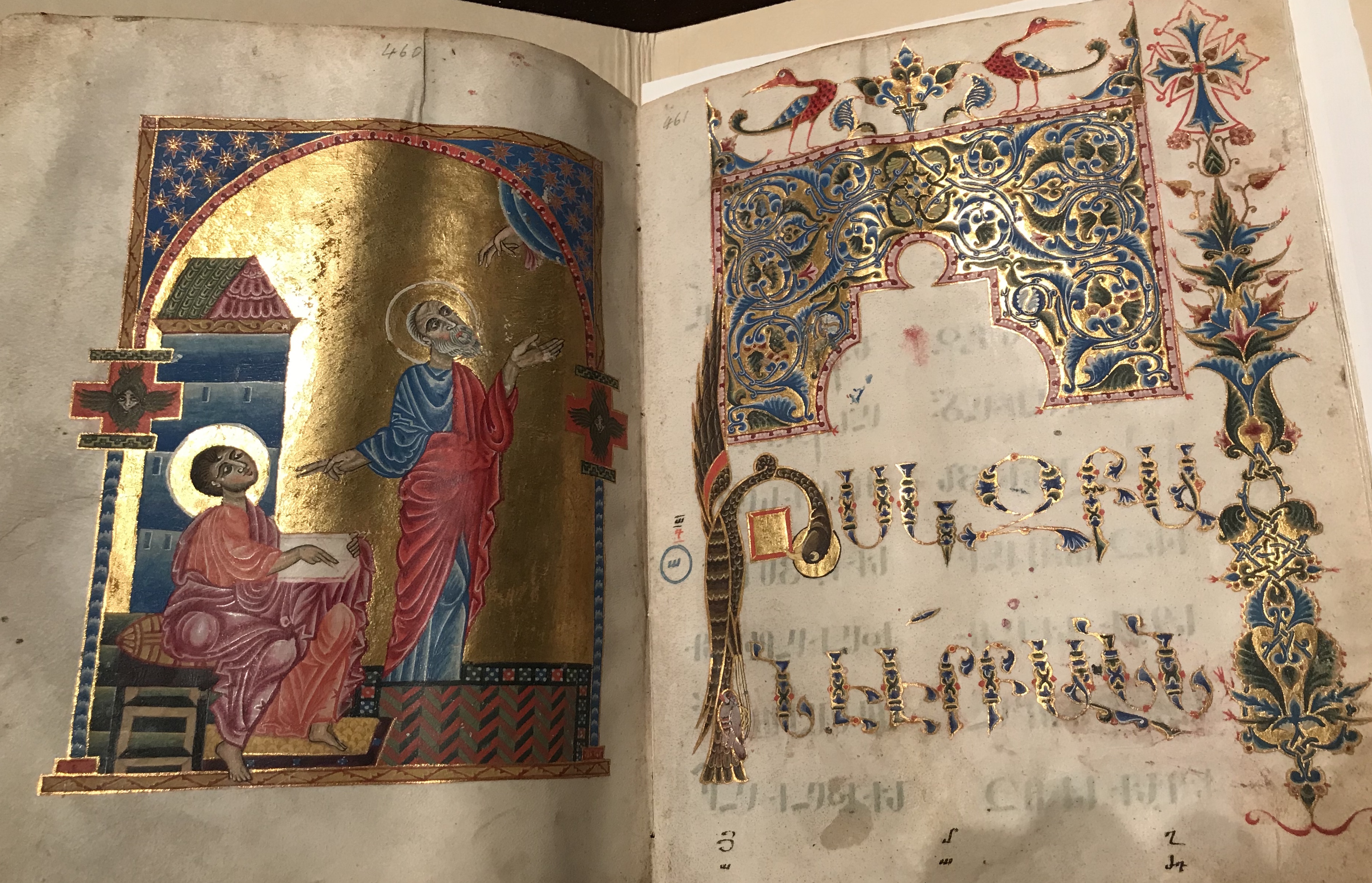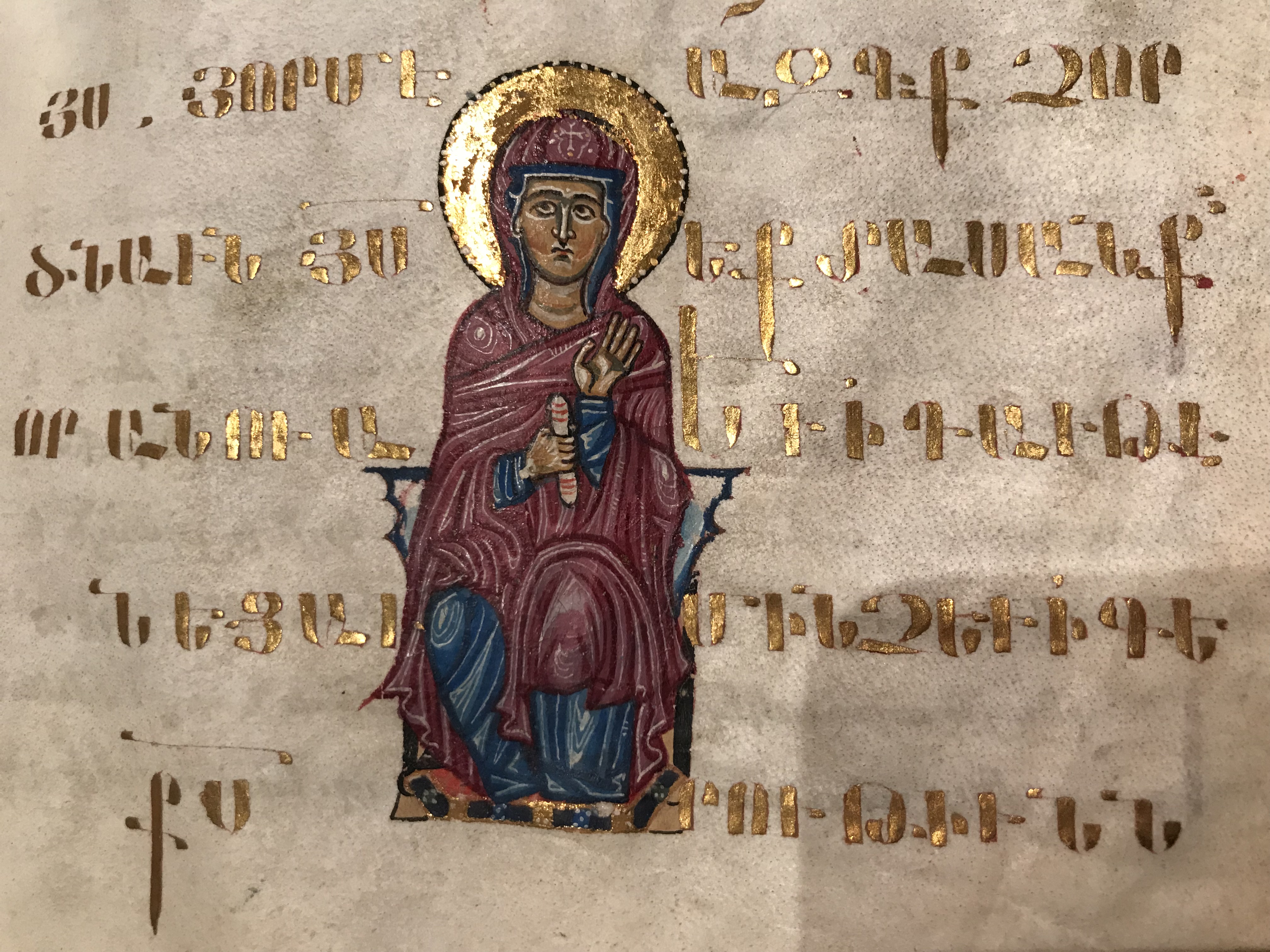
Figure 1. On the left is the portrait of the Evangelist John and Prochoros. On the right, the incipit to the Gospel of John reads "In the beginning was the Word".
Note the initial letter of the opening line; formed by an eagle, the symbol of Evangelist John, with a gospel held in its beak. Work of the second painter and the principal scribe. [Gladzor Gospels: pages 460 - 461].

Figure 2. Detail of Eusebius' Letter to Carpianos, with portrait of Eusebius; work of the first painter and sample of 'bolorgir'; work of the second scribe. [Gladzor Gospels: page 4].

Figure 3. Virgin Mary. Detail from the last page of the Genealogy of Christ in the Gospel of Matthew, where Joseph, Mary and Jesus are depicted. Initially, the work of the second painter later reworked by the fifth painter, T'oros of Taron, to maintain consistency of Virgin's image throughout the manuscript. The lettering is in large gold 'ergatakir', work of the primary scribe. [Gladzor Gospels: page 35].
The Gladzor Gospels: Illuminated Manuscript, 1300-1307
“By reason of its extraordinary wealth of iconography, its variety of styles and high quality workmanship, and its excellent state of preservation, the Glajor Gospel, must be ranked as the most important manuscript from Greater Armenia to have reached the New World” (Sanjian, 1999, p. 53).
This exquisitely illuminated manuscript of the four gospels is one of the ‘golden’ gems of the UCLA Special Collections. It was produced between 1300 -1307 in one of the most important Armenian monasteries at the time named Gladzor, in Armenia. Gladzor was an intellectual center and boasted a renowned university. It was attacked and destroyed in 1340. The site of the ruins still exists in modern Republic of Armenia. Intellectual pursuit is essential to understanding the iconography of the Gladzor Gospels. This was a time, under the Mongol rule, when branding the Armenian Christian identity, the first nation to adopt Christianity as state religion, and setting it apart from both the Eastern Orthodoxy and the Roman Catholic dogma was of utmost importance.
Click here to access the fully digitized manuscript.
This eloquent manuscript, made up of very fine vellum, is the work of two scribes and is luxuriously illuminated by five painters, of whom four are unknown. The entire text of the four gospels, including the incipits and prefaces, is written by the principal scribe in ‘bolorgir’ (cursive) script, in classical Armenian language (considered the “Latin” of modern Armenian). The initials of the verses, the first lines and the sacred names are in large gold ‘erkatagir’ (uncial); which literally means “iron-forged letters”. A prime example of the text illustration in golden ‘erkatagir’ is the initial eight pages of the Gospel of Matthew: The Genealogy of Christ [see figure 3].
The second scribe wrote the text of the Eusebian letter, the numbers in the Canon Tables1 and throughout the manuscript he provided aids in red pigment and data at the foot of the page to help locate a passage in question. In the Armenian tradition Canon Table illumination was the most important, even when the rest of the manuscript was not illustrated. It indicated the exegesis of the Armenian faith: leaving impurities outside and entering the sacred garden of the gospels [see figure 2].
In addition to many decorative, floral, tubular or bird-form pericope initial letters, and marginal ornaments, the five artists, each with his distinctive style, embellished this masterpiece with four evangelist portraits, four incipit pages, ten Canon Tables, and fifty-five narrative scenes from Christ’s life with fifty-four different characters. The color palette is mostly gold and vivid polychrome, making this manuscript a luxury item. On the incipit page to each gospel, each Evangelist’s emblem is represented in a large zoomorphic letter, carrying a gospel book, as is customary in Armenian gospel iconography [see figure 1].
Illustrating Christ’s life not only in the gospels but also in other personal manuscripts, such as psalters was the norm in Armenia. Gospel miniatures served as guided visual extension of the literary commentary on the text. These were not pure adornments, but didactical illustrations that assisted in elucidating new interpretations of the Gospels to keep the faith current and personal to both the clergy and the laymen. For example, in the Genealogy sequence, each of the forty-four portrayed ancestors of Christ is enthroned beside his name and the series begins and ends with Christ’s figure. Per Dr. Matthews, this is one of the “richest treatment of the Genealogy in medieval manuscript art, whether in the East or the West” (Mathews, 1991, p.86) and fits perfectly in the unique biblical and historical importance of genealogies in the Armenian tradition.
The provenance of the Gladzor Gospels is well documented in the colophons, which is customary of Armenian ownership. Colophon culture in the Armenian tradition dates to fifth century CE. It is unique in the sense that not only the original scribe wrote colophons at the end of a manuscript, at the end of certain sections or even in the margins, but also subsequent owners added colophons in the form of inscriptions and prayer requests throughout the codex. The first owner of this manuscript was the rector of the Gladzor monastery and the last owner was Dr. Garo Minasian who donated it to the UCLA Research Library in 1968. Per Armenian superstition, a sacred illuminated manuscript should not be sold, purchased or profited from, as it would bring suffering for posterity. Damnations were explicitly written in colophons, as is the case of the Gladzor Gospels [MS pages 579-580].
Credits: MS.1: Gladzor Gospels, Collection of Armenian Manuscripts (Collection 2089). UCLA Library Special Collections, Charles E. Young Research Library, University of California, Los Angeles.
Notes
1 Canon Tables are set of tables developed by Eusebius of Caesarea in the fourth century to display the concordance of the four Gospels. Each column of numbers in the table indicates a passage from a single Gospel. Read horizontally, each row of numbers identifies where the same event is described in other Gospels. These tables are often preceded by the letter of Eusebius to Carpianus, in which Eusebius explains his system. ↩
2 Mathews, Thomas F. and Sanjian, Avedis K. Armenian Gospel Iconography : the tradition of the Glajor Gospel. Washington, D.C. : Dumbarton Oaks Research Library and Collection, 1991: Major monographic study by art historian Thomas F. Mathews, Professor at the Institute of Fine Arts of New York University and the late UCLA scholar Avedis K. Sanjian. ↩
3 Sanjian, Avedis K. Medieval Armenian Manuscripts at the University of California, Los Angeles. Berkeley : University of California Press, 1999: Detailed catalog descriptions of ninety-one items in the Armenian Manuscript Collection in the Department of Special Collections at the University Research Library of the University of California, Los Angeles. ↩
4 Mathews, Thomas F. and Taylor, Alice. The Armenian Gospels of Gladzor: the life of Christ Illuminated. Los Angeles, CA : Getty Publications, 2001: This book was published on the occasion of the 1700th anniversary of the founding of the Armenian Church, during which the manuscript was displayed at the Getty Museum from August 28 through December 3, 2001. ↩
5 Sanjian, Avedis K. Colophons of Armenian Manuscripts 1301-1480 : a source for middle Eastern History. Cambridge, MA : Harvard University Press, 1969: Selected, translated and annotated by the author, this volume contains invaluable information on local and regional historical events. ↩
This spotlight exhibit by Liza Mardoyan as part of Dr. Johanna Drucker's "History of the Book and Literacy Technologies" seminar in Winter 2018 in the Information Studies Department at UCLA.
For documentation on this project, personnel, technical information, see Documentation. For contact email: drucker AT gseis.ucla.edu.